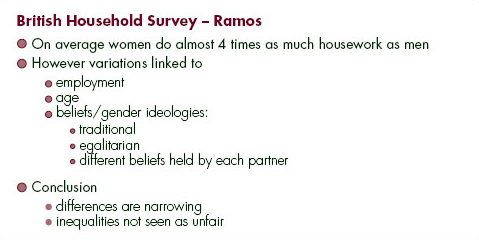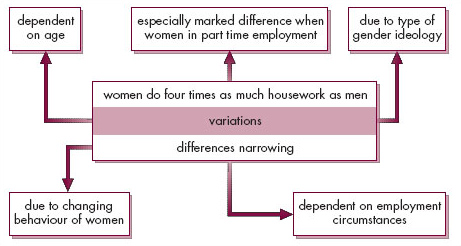1.2 How have these changes affected the division of labour within families?
What have been the implications of these changes for a woman's role as housewife? Has she continued to do most of the work in the home or has it become more shared between men and women?
For a while, particularly during the 1960s and 1970s, there seemed to be some indications that families might be becoming more egalitarian, i.e. that as more women worked outside the home, men would increase the amount of domestic work they undertook. A particularly influential study at that time was Young and Willmott's The Symmetrical Family (1973) in which they argued that the middle classes in particular were leading a trend towards a more egalitarian ‘symmetrical’ marriage relationship in which husband and wife shared tasks more equally.
However, evidence also emerged during the latter part of the twentieth century that perhaps changes had not been as great as was originally assumed. According to one review of the evidence ‘none of the data seems to warrant any suggestion that the traditional female responsibility for household work has been substantially eroded, or that male participation has ‘significantly increased’ (Morris, 1990 p. 120). Women it seemed had a dual role, juggling paid employment and work in the home.
So studies from the second half of the twentieth century told two different stories. On the one hand housework was becoming more equally shared. On the other, women still did most of it whilst at the same time working outside the home. Almost certainly some of you reading this will want to support the argument that change has occurred. Maybe it is part of your own experience than men today do a lot more in the home that their fathers’ generation did.
Equally, some of you may feel that the argument that there has been no change better reflects your own experiences.

So how are we to make sense of these different conclusions? And what does the evidence tell us now in the twenty first century? The next extract provides us with more recent evidence. It also provides the tools for thinking about why our experiences might be different.
Activity 1
Read the extract ‘Working up a sweat’ by Ivor Gaber which is a summary of an extensive research document. Although it is short, the extract contains a lot of different ideas which can make it quite difficult to ‘digest’. So when you have read it once, return to it and either draw a diagram summarising the factors which seem to influence the way housework is shared, or list these factors as a series of bullet points. (If you are not sure what these instructions mean have a quick look at Figures 3 and 4 in the discussion before you start.)
View document [Tip: hold Ctrl and click a link to open it in a new tab. (Hide tip)]
So according to this research, women's continued high levels of employment outside the home have not been accompanied by dramatic changes in who does the work in the home although there have been some changes. However there are differences between families according to age (though discussion of this factor is not developed in the extract from Ivor Gaber), the amount of work that women do outside the home, and the beliefs (gender ideologies) of the couple. It is to this third factor that we want to turn finally in looking at the division of labour today.
Reflection
We cannot give a short simple answer to the question of who does the work in the home. However we know that changes, varying in extent, speed and direction, have occurred to women's role during the past two hundred or so years. We know that they are at least partly explained by the connectedness between women's role outside the home and their role in the home. We also know from the Ramos research that families differ in how work is divided. This diversity, which is explored further in the rest of this course, makes it even more difficult to produce one simple answer to the question in this section's title.


